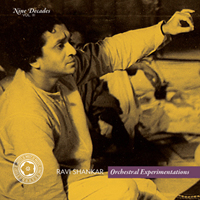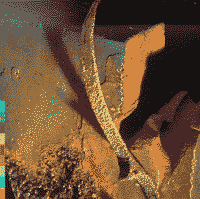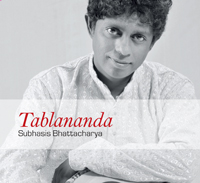
SUBHASIS BHATTACHARYA
TABLANANDA (Riverboat TUGCD1110)
This is the second Bhattacharya family spin-off album I have reviewed in as many months. I think they have a secret pact with World Music Network. However, let me say they are all worthy of your attention (and stand by for a different Bhattacharya coming next month!). I get a lot of music over the transom, and the fact I only post a few reviews per month means I listen to it and evaluate it before most of it gets dismissed: some of it after a few bars because it's crap or irrelevant to me, then there are those with a good opening cut that then go nowhere -- but the ones I like take you on a journey where they already know the route but are willing to make detours and have surprise parties on the way to keep you attentive. Subhasis is the understated tabla accompanist on his brother Debashish's many wild recordings on his homemade guitar. For his first solo outing he assembles an impressive cast of sidemen on western instruments such as guitar or trash can, or Indian instruments like dholak, bansuri or sarangi. The album was recorded in Santa Cruz, California and Kolkata. Subhasis rips through it on his skins like a dervish. He plays a dozen other percussion instruments, according to the liner notes, so I am guessing they overdubbed like crazy. But the layers work well and it seems like most of it was improvised on the spot. For example on "Senegalese Impulse" he brings in Ibou Ngom on sabar and djembe and the two just go at it for four and a half minutes. Intense doesn't begin to describe it. There are waterphones, which sound like Harry Partch devices on "Deep water syllables," and while they are otherworldy, Subhasis fits in well to ground it.

ALI AKBAR KHAN
ROUGH GUIDE (RGNET 1373CD)
There's a nice reference in the liner notes for this new compilation to Claude Debussy's opinion that "music is a matter of colours and rhythmical time." Although i cant find the source of this quote on Google it makes sense: Debussy, like Erik Satie, was interested in mood and expression more than structure and strict tempo. Those French guys created cinematic music before the full potential of the cinema was even realized. And like those two Frenchmen, two Indians shared the world stage a half century later with their similar yet distinct compositions as they popularized Indian classical music beyond the subcontinent. By far the more famous is Ravi Shankar, the Hindu sitar player. On the other hand Ali Akbar Khan, a Muslim, was the maestro of the sarod, a shorter metallic instrument -- the yin to the sitar's yang. And this new Rough Guide takes the same approach as the Rough Guide to Ravi Shankar which came out recently. Early in his career when Khan first recorded, the limitations of the 78 shellac meant you could only fit 3 to 4 minutes on a side of a disc, so he had to take what would be a half-hour long raga and distill it to the essence. Just sketch the story. So we have two opening cuts that are from early in Khan's career (complete with a grinding sound in the background from the surface of the disc), and then three longer tracks from his mature years and we end with a coda that again returns to brevity, as a nightcap. (I think they could have dispensed with the closer, having made the point at the outset, as the sound quality is weaker.) The music is very poetic and evocative -- of many things. My first image is always of black and white riverscapes with reeds because of the powerful impression the Apu trilogy made on me, but then my mind wanders, trains, printing presses, trees, smoke, clouds. Then I think about the relation between tabla and tablature: Indian music is improvised so probably not written down but handed on by demonstration. And you cannot notate accurately the muscular inexactitude in the rhythm of four fingers rapped on a drum in quick succession, bringing us back to those Frenchmen who would say, "imbibet (like a drunk)" or "robotic" rather than commit to presto or lento. The three long pieces on this disc are full of grace and loveliness.
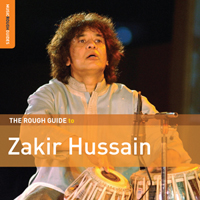
ROUGH GUIDE TO ZAKIR HUSSAIN (RGNET1372CD)
Not all music has to hit you upside the head and make you jump up and down. We all need those peaceful moments when we want to hear some soothing melodies and let our minds wander distractedly without being forced to pay attention to a clever solo. On the other hand even low-key music can draw you into the subtleties and make you hear the gaps or notice the interplay between the percussion and the spaces left by the melody. Zakir Hussain is perhaps the greatest living tabla player. He learned from his father Alla Rakha who preceded him in that elevated position. (I accidentally wrote "table" player which is true, as his father taught him by having him drum along with his fingers as a baby.) With two hands and two small drums he can play melodies or trade licks with the best of them. Here are five tracks that demonstrate his skill. On "Kirwani" he plays along with a santoor, a Kashmiri folk instrument which sounds like a dulcimer, sweet and refreshing like a cool shower on a hot day. Hussain's hands move fast, like talking, his fingers reciting tales, fables, finishing the narrative begun by the strings to the point where he is really excited, making his point, and you are suddenly paying full attention. This compilation is more than a best of: it allows us glimpses of different facets of Hussain's art, mostly in duet with a stringed instrument.
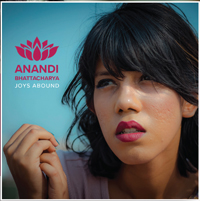
ANANDI BHATTACHARYA
JOYS ABOUND (Riverboat Records TUG1116)
I saw Anandi in concert a few years ago. That is to say, I saw her father Debashish perform in Chicago and he prodded the shy young teen onto the mike to do a number. The good news is she has blossomed into a fine singer and on this album is backed by her dad's band. Debashish plays slide guitar and uncle Subhasis plays tabla. There are guests on djembe, mandolin, keyboards, flute, cajon and percussion but all very unobtrusive. Lata Mangeshkar is now 88 and hopefully enjoying retirement but you cannot avoid a comparison to the fine voice who graced so many (thousands) of popular Hindustani songs. But Anandi also cites Ella Fitzgerald and Joni Mitchell as influences. The music here sounds traditional, and includes an invocation to Ganesh, folk songs, and even a Rabindranath Tagore poem set to music, but all the compositions are original. Included in the band is Carola Ortiz, a clarinetist and singer from Spain who adds another dimension.
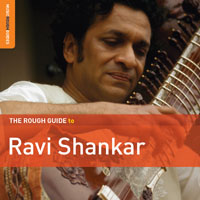
ROUGH GUIDE TO RAVI SHANKAR (RGNET1371CD)
This retrospective look at Ravi Shankar's vast oeuvre has an interesting twist. The compiler, who is also a biographer of the Pandit, has chosen to showcase one raga, "Tilak Shyam," in two versions. The first is an early recording made in the era of 78s which were cut directly to shellac and limited to about 3 minutes (despite what you may think, the sound is fine on this). The second, recorded in 1966 on reel-to-reel tape stretches out to the full 24 minutes of the maestro and his accompanist, Kanai Dutt, in full flight. Starting from Bengali roots, Shankar adapted folk songs (& dance) and rose to the heights of global recognition. His lyrical score for Satyajit Ray's Pather Panchali (1955) won awards at Cannes and promoted Bengali culture to a Western audience. The film was based on a story by Rabindranath Tagore, who won the Nobel for Literature in 1913-- he was the first non-European to do so. Ray adapted other tales for his film Teen Kanya and Shankar collaborated retroactively with Tagore on such masterpieces as Kabuliwala, which has been filmed at least four times. Shankar's global fame was hastened by his association with the Beatles, as well as Western classical musicians like Yehudi Menuhin, but either way, the world was ready for his sophisticated theme and variations and the raga became a popular form of entertainment in the 1960s when people were looking for ways to tune in and relax. Listeners instinctively knew you had to enter the raga and experience it in the moment, and that the performer was facing the same challenge: to follow the instant in interpreting the theme. Shankar's sitar offered morning, evening and night ragas, most of which could be enjoyed at any time of day or state of mind, and no two were ever the same. Another short piece, the 6-minute "Megh" references clouds and is a raga for the rainy season. This CD is abridged from A Journey through his Music, a 10-disc box set that came out on the Document label in 2006. The last track comes from a 1991 live show with Zakir Hussain on tabla, first issued by EMI in India. Like Rabindranath Tagore's stories and Satyajit Ray's films, Ravi Shankar's music is ultimately a monument of human culture.
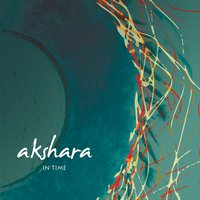
AKSHARA
IN TIME (Blue-Skinned God Records)
Simply a lovely set of traditional Indian Carnatic music. Despite audible appearances, the group is from New York though they ply traditional instruments: the double-headed barrel-shaped mridangam drum, tabla, bansuri flute and hammered dulcimer. Bala Skandan the leader is the drummer who sets the pace with complex rhythms. He also studied violin as a lad, but the drum was his first love as he could always hear it emanating from temples, unamplified. And if there was a wedding going on, you knew from the sound of the drums. Skandan worked for a while in London (one of the tracks is called "Mind the gap"!) where he would put together Indian ensembles for one-off concerts. Now based in New York he has not hesitated to bring cello and viola into the mix because he feels they fit so well. One cello player got married so he brought in another from Brooklyn Raga Massive and now they have two cello players as needed. The album, of traditional ragas from both the Carnatic and Hindu canon, is perfectly sequenced and at 45 minutes leaves you wanting more.
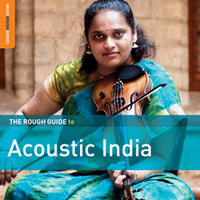
ROUGH GUIDE TO ACOUSTIC INDIA (RGNET1361CD)
Some people I know -- and not just Euro peons -- don't get Salsa. I am always curious why: maybe because there's no lead guitar and the piano is often a percussion instrument. Or maybe it's the upbeat tempos urging you to dance that seem too trying. Classical Indian music is also met with resistance: again I think due to cultural misunderstanding. The complex rhythms take some getting used to and also there's another set of instruments quite different from the ones we are used to: a piercing flute, a deep woody cello sound, and the droning "sympathetic" strings. But study is rewarding and the latest Rough Guide is a wonderful tour of some lesser-heard modern sounds from the vast elephant-ear-shaped sub-continent. Sometimes we glimpse traditional Indian sounds in Bollywood, but usually they are set against a wash of synthesizer loops or stereo-chorus strings, showing that even Indians see exoticism in their own traditions. There's the strictly traditional raga performed on sitar and tabla that made an impact in the West. Gradually we have been exposed to other strains, such as Debashish Bhattacharya, who plays his own modified guitar, and indeed plays ragas on it, so has adapted the format of the sitar and tabla "exposition and variations" to his own ends. This is one highlight of the album. And there's Paban Das Baul, a wandering "madman" whose album Music of the Honey Gatherers is sampled here and demonstrates the trance groove that Cheb i Sabbah and others found in traditional Sufi music. Here Rough Guide has managed to stay within its own catalogue and given us a sampler of eight exceptional albums they have released mostly through their Riverboat subsidiary. My old friend Hameed Khan pops up with his Jaipur Kawa Brass Band in an oddly elliptical snare-driven theme. Yes, even I (with my doctorate in rhythm) find myself looking for the "one" sometimes. The jagged melody occasionally suggests music for film, but the trombones appear to be playing a different melody to the trumpets!
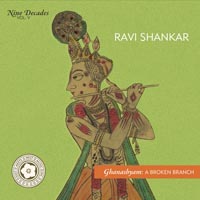
RAVI SHANKAR
RAVI SHANKAR'S GHANASHYAM (A BROKEN BRANCH) (East Meets West Music)
Volume V of the Nine Decades project (which is unearthing and restoring lost gems from Ravi Shankar's back catalogue) is a big change from his sitar and tabla pieces, in fact he doesn't play on it. It is the score for a ballet he wrote for the Birmingham Opera in 1989. At the time he felt that people equated Indian music with drug trips (in many movies, starting in the 60s, a swirling sitar and a kaleidoscope of colors was shorthand for dropping acid) and wanted to counteract this. The preoccupation with drugs, he felt, was an "easy escape from the sadhana found in disciplined hard work." Those of us who reveled in drug experiments in our youth know how close you can come to losing it, and the fact that America is in the grip of drugs like Oxycontin, Fentanyl or crack cocaine shows how bored and spiritually empty large swaths of the population are. The prescription drugs are overused to the point of inertness, which of course makes good politics as a docile out-of-it populace is easily manipulated. Shankar wrote this music in the folk-tale tradition. Not only did he have experience in writing full-length scores, he had also spent his teens dancing in his brother's touring troupe. His soundtrack credits begin in the 1940s and in the 1950s he scored some of the great films of Satyajit Ray, including the Apu Trilogy. Then he went on to the 1957 Kabuliwala, Jonathan Miller's Alice in Wonderland (where, yes, his music does suggest altered states) and Richard Attenborough's Gandhi. For Ghanashyam he drew from all Indian traditions, northern Kathak style and southern Kathakali, and also added in Western classical ideas to the Indian orchestra. Ghanashyam is a dancer and his descent into drugs horrifies his wife, Lalit, and his fellow dancers. A bell rings and you think, ah that's to awaken the gods, then it rings again as other instruments enter and soon it is jingling like anklets, and we remember dancing can also be an act of worship. Well-known playback singers Ashit & Hema Desai sing the lead parts. There's Vishwa Mohan Bhatt on guitar. Violin, sarangi, sitar, flute and shenai add color. The result is a lyrical score with a cinematic sweep. And for the first time the full-length (80 minute) work has been restored from the original tapes.
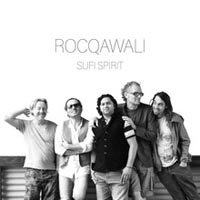
ROCQAWALI
SUFI SPIRIT (Riverboat TUGCD1099)
I must have watched scores, if not hundreds, of Bollywood movies. I have my favorites among directors, actors, actresses and playback singers. The big historic dramas often have moments of spiritual reflection (before or after a battle scene) and quite often secular singers, like Mohammed Rafi or Lata Mangeshkar were called on to plumb the depths of Islamic devotion for the on-screen characters. Muslims too got the chance to sing behind the screen and many films have been boosted by the presence of Nusrat or Rahat, Jagjit Singh (a Sikh who revived the ghazal form) or the Wadali Brothers. You may find it incredulous to expect transcendence from a film soundtrack but that's what happens in ecstatic moments like A. R. Rahman's "Khwaja mere khwaja," the central moment of the 2008 film Jodhaa Akhbar, when the male lead escapes self to find the divine. This new album is described as a blend of rock and qawwali but to me it's pure Filmi. Despite their political and religious differences, exacerbated by the current "strongman" Trump-clone Modi in Delhi, Pakistan and India share a love for the Sufi devotional music, and as a militant atheist, I am also partial to it. The singer is Ejaz Sher Ali whose father Sher Ali and uncle Meher Ali are famed qawwali singers, being trained in the same tradition as Nusrat. The omnipresent but thoughtful guitarists are Danes: one of Iranian extraction, the other Pakistani. The group is completed by bass and drums: there is no bare bones hand-clapping accompaniment, but someone is in the studio with a synth adding some atmosphere. The rock edge is kept below the vocals and helps emphasize the wild abstract vocalizations of the singer Sher Ali who is superb. They don't have a video, which is fine by me, the movie in your head is always the best one.
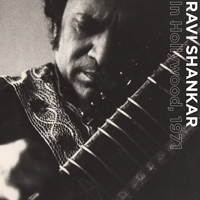
RAVI SHANKAR
IN HOLLYWOOD 1971 (Northern Spy Records NSPY073/EMW1015)
If you should get up with a clear head and a fresh outlook and think it's time to put on a Morning raga to focus your mind, then this is the album for you. It's a rare private recording that Ravi Shankar made at home on 12 June 1971. There's two hours of music in four movements. At Ravi's Highland Avenue home that morning some celebrities were gathered to hear the master, and Ravi, being Bengali, addressed them about the plight of the people of East Pakistan (as his homeland had become) after Cyclone Bhola had hit it and the much bigger West Pakistan had invaded it. After the cyclone the government response was so weak there were calls for independence, but the duly elected Socialist leader was prevented from taking office by a military coup, in which over a million people perished. Ravi spoke to the gathering and performed for them: his concerns motivated George Harrison to organize the Concert for Bangladesh at Madison Square Garden. That morning, in addition to the Beatles and Peter Sellers, Zubin Mehta and Marlon Brando were hanging out. But there was another legendary musician present, and playing (no, sorry, not Frank Zappa), and that is Ustad Alla Rakha, Ravi's accompanist on tablas for 25 years, who gets little grunts or sighs of approval for his participation, particularly in the incendiary closer "Sindhi Bhairavi." The sound has been remastered from reel-to-reel tape and is clear; as many of the famous big stadium concerts he made at the time were in the evening, Ravi did not record many morning ragas. The four original compositions are by Shankar and the liner notes explain their inspiration (a trip to his birthplace) and musical structure (the life power of each raga is explained in philosophical terms that are most interesting). One ("Hollywood Dhun") is based on a Bengali folk tune and conjures up, as always, the lyrical black and white imagery of Satyajit Ray. You always learn something from Ravi and there is much to enjoy.
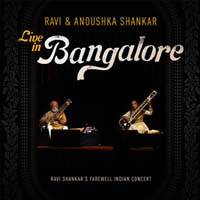
RAVI & ANOUSHKA SHANKAR
LIVE IN BANGALORE (East Meets West Music EMWM1014)
Indian classical music, in the form of ragas, took the world by storm in the 60s. It wasn't just that it broke the mold of Western classical forms and the rigid 4/4 of pop music, it suspended time, took another approach to tempo and rhythm. When you added the narcotic effect of incense, it provided an escape to other worlds which were the domain of the imagination, a musical dream time that we all share yet is unique to each of us. Ravi Shankar was not only the ambassador who brought Indian classical music to the rest of the world, he was its greatest exponent. The hallmarks of his career are hard work and shared joy. His final Indian concert is presented here, both in a double CD set and a DVD of the performance. We don't know about the status of women in Indian classical music though Bollywood movies would suggest that only courtesans were trained as entertainers. However Shankar trained his daughter as inheritor of his mantle and she carries the concert and shows how well he invested her with his skill in improvisation. Via the DVD we can see that he is frail and apologetic, and leaning on his daughter throughout the first number. But then he announces one of his favorite compositions, "Tilak Shyam," and starts into it. It's almost like he is teaching her again, he plays a phrase and she repeats it, then he improvises on it and she does too, back and forth. As the tempo builds he starts trading faster, more complex licks with Anoushka and the tabla player, Tanmoy Bose: the years drop away, suddenly he is ripping it out and creating blistering runs and she looks amazed. After 25 minutes we know he is eternally young, he inhabits the music and it tells his fingers where to go. It's a three hour show, performed in the grounds of the Bangalore Palace two months before Shankar's 92nd birthday. As a bonus the DVD includes another full set from Anoushka, the opening from the Palace show. She not only inherited her father's mantle, it fits her to a T.
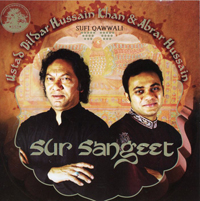
USTAD DILDAR HUSSAIN KHAN & ABRAR HUSSAIN
SUR SANGEET (Kanaga System Krush KSKCD015)
Thus far Kanaga System Krush has been a publisher, almost exclusively, of music from Mali. For their 15th release they move to Pakistan for a rousing set of traditional Sufi qawwali music. While Nusrat opened our ears to this magical sound it has a centuries-old tradition and is still a vital and growing part of Sufi devotional rituals. In fact, Dildar Hussain was tabla accompanist for Nusrat for over three decades, and has now formed his own Qawwali party with three of his sons. There is a second tabla player, Israr Hussain, in addition to harmonium and handclaps accompanying the singers. The lead singer is Abrar Hussain but the tabla playing is equally to the fore as there is an amazing bass thrum going on thanks to the older "Jori style" of drum which the father plays. Son Israr also gets to solo on tablas on half the tracks. Most of the songs are traditional poems or scripture but some new lyrics have been added; "Ali Moula" who married the daughter of the prophet, was called the Lion of God, so singing his praise invokes strength. Other new material is created when it is composed for a movie soundtrack and becomes a hit (Dildar backed Nusrat on several successful soundtracks, including "Last Temptation of Christ," "Dead Man Walking" and "Bandit Queen."). Now that there is cinematic détente between India and Pakistan, some Bollywood films with hit soundtracks, which have been known in Pakistan for decades are actually getting shown on the big screen for the first time. Dildar Khan comes from a musical family and by 15 had started accompanying the young Nusrat who was already making an impression. He was able to study with Ravi Shankhar's famous accompanist, Alla Rakha, another of the Khan family. Thus he added Indian classic riffs to his Punjabi style. The groove is rock-solid, the singing spiritually uplifting.
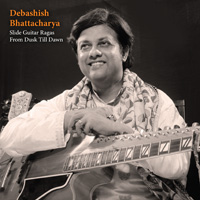
DEBASHISH BHATTACHARYA
SLIDE GUITAR RAGAS FROM DUSK TILL DAWN (TUG1083)
Bhattacharya plays a homemade guitar with added sympathetic resonating strings. "Homemade" sounds a little ad hoc but it was custom-made by Gibson from his design to have the regular six strings, plus four supporting strings, two drone strings and twelve sympathetic strings. In this suite of ragas he sounds closer to a sitarist then ever before; even the format of the music reminds you forcibly of the conception and execution of Ravi Shankar's work (Bhattacharya cites as an influence another sitar virtuoso, Ustad Vilayat Khan). The set is positioned at night beginning at dusk with "Aarti (the evening ritual)" which sets the scene for a mellow hour even if you don't plan to stay up all night. Bhattacharya attacks his strings with three fingers, a plucking technique adapted from the ancient veena, an ancestor of the sitar. By the third track the attack quickens and a tabla enters the dialogue. Rather than fading out the album builds and Bhattacharya throws in his whole bag of tricks from the Hawaiian slide to some Latin riffs and a notable flamenco influence in his flourishing on the last track "Vasundhara (Mother Earth)."
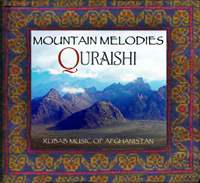
QURAISHI
MOUNTAIN MELODIES (Evergreene Music)
This is traditional Afghani music and it is a magic carpet ride. Quraishi plays rubab, a lute-like instrument, and the accompaniment is simple hand percussion, tablas or dhol. The melodies are sweet and hearken to an earlier time before Afghanistan became a cultural wasteland. It is increasingly difficult to find live music in Afghanistan and it is no surprise that Quraishi left his native Kabul for New York where this was recorded. Like a Renaissance therbo, the rubab has three strings that are played to articulate the melody then as many as twenty sympathetic strings that are tuned to the ragas and create their own unique timbre. (The therbo has six main strings and a lot of sympathetic ones.) Quraishi grew up in a family of musicians and instrument makers and studied classical Hindustani forms. There is also a strong suggestion of Sufi trance music in the call and response between the rubab and the tablas. The percussionist Chatram Sahni is adept at creating backbeats. He spent his youth in the 1970s accompanying many now-famous singers on Afghan radio. Quraishi is not only a master musician he has a lot of soul in his fingers. He will be demonstrating his virtuosity on a tour to promote the album, arranged through the Center for Traditional Music and Dance. See the website for details.
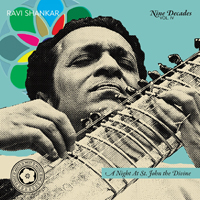
RAVI SHANKAR
A NIGHT AT SAINT JOHN THE DIVINE (East Meets West EMWM1013)
Now that Morgan Freeman has replaced Charlton Heston as the voice of God, it's time to assess his abilities against another box-office giant who is regularly called on to voice the divinity: Amitabh Bachchan. But it doesn't take too many snippets to figure out who'd win a divinity throwdown or God-off. When it comes to Vox Dei or Godvoice, Amitabh wins handily. Indeed, he is already a minor deity in the Land of 10,000 Gods and you know no one does deep spirituality like the Hindus. Christianity is bound up in guilt and pettiness. Its main assets are the Jacobean translation of the Bible and its architecture. Now imagine we blend the two religions, and put Hindu spirituality in a reverend, resonant and reverberant Christian space: the Cathedral of St John the Divine in New York. For volume four of the Nine Decades series, dedicated to issuing the best recordings of Ravi Shankar in an orderly fashion, East Meets West has opted for one night that Ravi spent in church on a bill with a host of other acts from dusk to dawn. The first piece is an afternoon raga. As Ravi says, "we are worshipping the divine sound in the house of God." The musician and the listener become one, he tells us, as eyes closed, we nod in consent. Then, on cue, he explains the metre of the next piece, four-four-one-half-one-half. No one laughs; no one goes, Huhn? Apparently, by then, the sun was rising (Ravi is the Sanskrit word for "sun") and as the light poured through the stained glass windows and the somnolent audience stirred in the pews, Ravi ripped into a sunrise raga, "Vachaspati," with his faithful accompanist Alla Rakha, one of the few musicians who could keep up with the master. There is an odd break-tempo moment about every nine beats in this piece: tapping it out on your knee is futile but you sort of sense it coming. Nevertheless there is a fluidity and grace to this work. It's nice to hear it in the comfort of your home and not in a coccyx-crucifying pew, but perhaps the mortification of the flesh, the long night ending and the holy dust suspended in the stained-glass-filtered light would add something. Who knows? you weren't there. Me neither. But, as Baba Ram Dass might say, you can be there now.
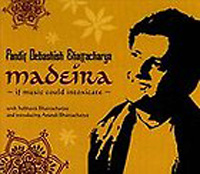
DEBASHISH BHATTACHARYA
MADEIRA (Tridev Music PDB-CD-001)
I caught Debashish in concert in Chicago last year. It was a great evening of music and a chance to watch this virtuoso of the Calcutta slide guitar up close (he even rocked out on a tiny ukelele, just to show off his chops). He builds his own instruments which have up to 21 strings. He brought his daughter, Anandi, as vocalist, and she seemed tentative, quite nervous, but now has gone on the mike in a recording studio and is ready to front the group which comprises her dad and her uncle as tabla accompanist. Like her dad she blends many different Indian styles in her approach to the music (she only appears on the last two tracks). It's a new direction and better than the road he was taking which led to a collaboration with "Mahavishnu" John McGlaughlin, called Beyond the Ragasphere, which was just a racket as far as I could hear. This album is back on track, with the sympathetic resonating strings and his brisk attack, it could easily pass for a sitar album. The tunes are approached as ragas and the tabla accompanist, Subhasis Bhattacharjee, is right on the one. He even drives the tempo, giving as good as he gets, and pushes Debashish to insane flights of speed on "Jhoom."
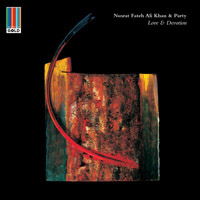
NUSRAT FATEH ALI KHAN & PARTY
LOVE & DEVOTION (Real World)
Originally released as two CDs on the RealWorld label, these two discs have been remastered and repackaged (in cardboard rather than plastic) to come to our ears once again. Nusrat was on the verge of international stardom in 1985 when he played the WOMAD festival in rural England. The label was the brainchild of Peter Gabriel who decided to invest in a state-of-the-art recording studio near his home in Wiltshire and get some of the visiting artists playing WOMAD to record. The first issue was his own Passion album. This disc and the Passion: Sources sequel (which had the raw material he had used to create his soundtrack) were followed by 200 albums of vast diversity, from Gospel to Sufi, from Ethiopian dub to Mexican ska. This gathering combines two albums released in 1992 by RealWorld: a set of love songs and a set of religious hymns. Frankly I can't tell the difference between ghazals and the Qawwali devotional hymns: they all sound good. From his repertoire Nusrat delivers storming versions of "Allah Hoo Allah Hoo," "Haq Ali Ali Haq," and "Ali Maula Ali Maula Ali Dam Dam." The only odd part is the addition of an acoustic guitar; there is also mandolin on some tracks. I am not a purist but this seems unnecessary, however at the time the producers probably felt Westerners would prefer a familiar instrument added in. On the love songs it lends the sound something more filmi. Nusrat's Mustt Mustt, released on RealWorld in 1990 completely changed British and Asian music. The Massive Attack remix of the title song was indeed massive. A whole generation of British Asian artists were energized, from Nitin Sawhney to Talvin Singh, and producers went wild creating dub remixes of Nusrat's vast output. RealWorld has also reissued Star Rise which is an early remix album of songs recorded by Nusrat and Canadian Michael Brook: nine tracks were given the drum machine and synth treatment by a variety of artists. At the time I thought it stank, and wouldn't give it any credibility. Now that we have heard Gaudi's superb treatment of some Nusrat vocals I thought my opinion might have mellowed. However there are still at least two unlistenable tracks, not because the technology is dated and sounds quaint, but because they are so overwhelming with their discoid insistence. So i say skip this one, but by all means check out the double disc of relatively pure Nusrat, and his love and devotion.
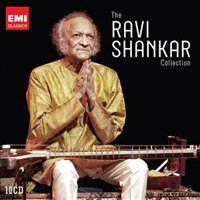
RAVI SHANKAR
THE RAVI SHANKAR COLECTION (EMI)
Ravi, like Nusrat, has now gone to his eternal rest, but left us an incredible legacy of hundreds of recordings to discover and enjoy. I recently got the ten CD set of Ravi that was put out by EMI in 2012. It contains recordings in various combinations and formats from 1967 to 1983. I skipped these in their day because I was dubious about the collaborations. You may like symphonic music but does it work with sitar? The first disc stars with a lovely raga "Raga Khamaj," with everything as expected: Alla Rakha on tablas, but then the same song is repeated with André Previn (or Andrew Preview as Morecambe & Wise called him) and the London Symphony Orchestra. It actually works. Obviously there's less improvisation because the orchestra has the riff written out and Shankar is bouncing off it, without going too far astray, not unlike playing to a pre-recorded playback. The second disc is his famous encounter with the yogi Yehudi Menuhin (who made his debut on violin with the San Francisco Symphony, aged 7): again you ask if Eastern and Western instruments are such a good fit. However it's what they wanted to do and it's not a disaster like say the Plastic Ono Band. This is followed by the second Sitar Concerto, this time it's the London Philharmonic under Zubin Mehta. It's very filmistanic, with kettle drums akimbo, and reminds me of Rimsky-Korsakov and other light classical stuff that was fodder for films in the 30s & 40s. It was recorded in 1982 and I am not totally against it. The second concerto works because Zubin Mehta was also Indian and realized it should be an Indian orchestral arrangement with the orchestra coming to meet Ravi, not the other way. So there is no brass. The tones of oboe that Shankar obviously loved are here (along with bamboo flute) as well as a lot of percussion as the orchestra tries to replace the rhythmic bed of the tablas. Mostly it's sprightly and folkloric like Percy Grainger or brings in plangent "full fathom five" harp tones, or rising flutey larks like Benjamin Britten. There are some lovely passages. Not included is the soundtrack for Alice in Wonderland, the Jonathan Miller version (which is arguably the best of the film adaptations of the novel), however the exquisite, brief (7 minute) theme for Pather Panchali is included. Ravi was no purist and so this set showcases many collaborations and even diehard fans will not like all of it. Disc 6 has Japanese musicians, Hindi singers and then a jazz group with Bud Shank on flute, Gary Peacock on bass, Louis Haynes on drums, and Dennis Budimir on guitar. Shank was a regular accompanist and appears often on these discs; Paul Horn made a 1964 Hollywood date as flautist. Of course John Coltrane, who named his son Ravi, studied with Shankar and hoped to collaborate but that never came to pass due to the saxophonist's untimely death. But no matter the setting, Ravi Shankar still shines through. I am still working my way through these, so may rewrite this review. There is a lot to explore in these discs and at this point, everything new from Ravi is welcome.
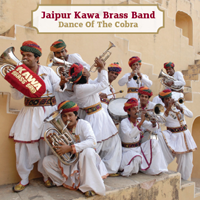
JAIPUR KAWA BRASS BAND
DANCE OF THE COBRA (Riverboat TUG1073)
Jaipiur is a magical city: I actually saw a blue ox pulling a cart. There's the lovely Hawa Mahal (or Palace of the Winds, glimpsed fleetingly in the Marigold Hotel movie) & a really fine Jantar Mantar, or astrological observatory. The Palace of Amber (or Amer) is another outstanding attraction. If you have the wherewithal you can ride a howdah atop an elephant up to the entrance. But my most memorable time in Jaipur was hanging out with Hameed Khan, tabla player and music impresario, for a couple of days. With his boundless energy, Hameed is keeping several musical scenes alive in Jaipur, from Qawwali to Baraat, and it's this latter, the traditional wedding brass band, we hear on this disc. Rawer than Romany gypsy bands like Fanfare Ciocarlia, more raucous than Bollywood Brass Band, Jaipur Kawa add sitar, jews harp (even bass guitar on one track), and snare drum to the army brass line-up of trumpets, trombones, clarinet and euphonium. The album is called Dance of the Cobra because the band performs with a snake charmer, fakir and dancer -- in fact it's more of a carnival than a musical group. The set opens with an Asha Bhosle classic "Piya tu ab to aaja," written by her hubby RD Burman. (You'll know it when you hear "Monica, oh my darling!"); "Mera Pyar Rahega Tere Sung" from the film Pehchan is next; a classic, "Gore Gore O Banke Chhore" from 1950s Samaadhi (originally sung by Lata), follows; I have been having fun playing the songs back to back with the originals found on YouTube. Fans of Hindi rock n roll will dig Mohammad Rafi's "Laal laal gaal" (from Mr X, 1957) as interpreted by Hameed Khan's band. The Rockabilly aspect of the original becomes a solid bomping waddling 60-year-old trying to do the twist. Maybe you will be inspired to check out the old film with its all-star cast of Ashok Kumar, Nalini, Helen, Pran, and the comic genius Johnny Walker. Another Mohammad Rafi song, "Jiya o jiya kuch bol do," is taken at a leisurely pace. Pakistani singer Noor Jahan's "Soniya dil da mamla" has been subjected to disco remixes and we get a frantic version of it here, complete with sung vocals. We come up to 1993 for the closer, "Yeh Kali Kali Aankhen," which was in the film Baazigar, a vehicle for Shahrukh Khan and Kajol. The music was written by Anu Malik. If you enjoy Bollywood escapism, remixes, or just the frenzy of brass bands going full tilt, this is for you.
RAVI SHANKAR
THE LIVING ROOM SESSIONS PART TWO (East Meets West Music, EMWM1009)
This may be the last new recording we get from Ravi Shankar, since he passed away shortly after recording it, at home in Encinitas, California, in 2012. Part One of these sessions won this year's Grammy for best World Music album (beating out his daughter Anoushka's latest), but Anoushka was there at the Grammies with Nora Jones to accept this, and a Lifetime Achievement Award for their late father. They joked about his profligacy and how he had "lost his Grammy" -- literally mislaid it. So they had called the Grammy office and asked if they could get a replacement. For which one? asked the receptionist. Turned out Ravi had won more than once but didn't know it. For fans of his music every album is a winner: he was a master of improvisation and whenever you listen to his music you never hear it the same way twice. Sometimes you might think he is pulling your leg, quoting "De Camptown Races" or another tune, then he flits off like a hummingbird to another musical source of nectar. Tanmoy Bose, longtime accompanist, is on tablas and two of his devoted students, Kenji Ota and Barry Phillips, play the drone parts. Ravi is unusually vocal on here, scat-singing the rhythm, you can almost see him nodding to Bose, like "that's it!" The album seems quite short at 51 minutes, but Shankar is great for putting us into dream space. At the end he exclaims, "Oh, this was fun! Great fun!" Thanks for everything, maestro.
INTRODUCING THE AHMAD SHAM SUFI QAWWALI GROUP (INTRO118DD)
The Ahmad Sham Sufi Qawwali Group has been performing traditional Sufi music in their native Afghanistan for over 30 years, notably at Kablui, I mean, Kabuli shrines. However during the Taliban's reign their music was banned. We can only hope that once the Western powers leave, the corrupt government will not implode and return to the barbarism that has ruptured this society for centuries with their hateful misogyny and totalitarian intolerance. Nothing could be more mellow than Sufi music and this selection of 8 tunes is a delight throughout. Rough Guide has this odd way of putting out these excellent INTRO CDs which get forgotten, but then a year later they put out a lame compilation and revive the INTRO or Riverboat disc as a bonus. They do this repeatedly, so if you forget to buy this when it comes out digitally in a few weeks (I guess they have to generate the electricity for the downloads first?), it will almost certainly reappear as the bonus disc on the Rough Guide to Mellow Muslims or something similar in the next year. If you are a fan of Nusrat you will want to check this out. I still listen to Ol Nusrat regularly since his was one of the greatest voices of the last century, but there is certainly room for more Sufi singers. The vocals (and instrumental tracks) are backed by harmonium, flute, tablas, tampura, and tambourine.

|
RAVI SHANKAR
Last time we checked in on Ravi (see my review of the CD Nine Decades vol II) he was a relatively young man playing to a crowd of hip and happening people at at a party in LA. It was the '60s and he was zapping his fans with lightning riffs. The 17-beat cycle was so fast he explained that he counted it at half speed, which made "8 and a half -- or Fellini!" Now he is a mellow 92 years old and has moved south to Encinitas, California, nearer the warmth of Mexico. There are four tracks on here. Though they are each called "Raga" none of them notably has the movements which make them like symphonic variations -- Allegro, Largo and so on -- or alap, jor, as he usually explains. Here he is chilling with his old pal Tanmoy Bose on tabla and the mood is tranquil and reflective. Great news for fans of Indian classical music that he is still recording brilliant improvisations.
|
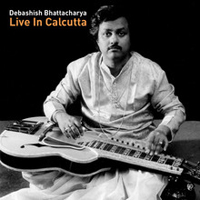
|
DEBASHISH BHATTACHARYA |
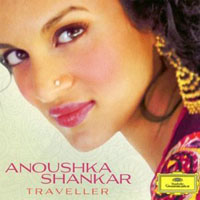
|
ANOUSHKA SHANKAR |
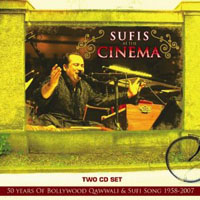
|
SUFIS AT THE CINEMA |
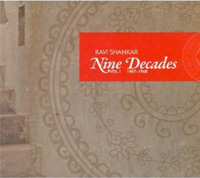
|
RAVI SHANKAR |
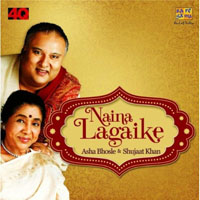
|
ASHA BHOSLE & SHUJAAT KHAN |
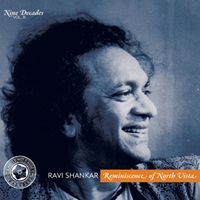
|
RAVI SHANKAR |
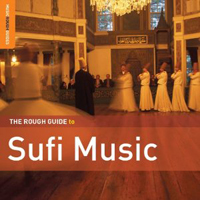
| ROUGH GUIDE TO SUFI (RGNET1262DD)It was not hard to break Sufi music to bigger audiences in India. Renowned for its secular tolerance (for the most part) the subcontinent readily embraced Sufi singing in Bollywood, its main form of entertainment, from the early days. The Pakistanis were less flexible and frowned on Muslims who "sold out" to the movies; the Taliban is so opposed to the blissed-out Sufis they regularly dynamite important shrines killing many fellow Muslims in their blind rage. But despite the unbending political aspect of extremist Islam, almost everyone else is ready to bask in the glorious music of their ecstatic spiritual fringe. The basic tenet of Sufism is entheogenesis, or that God is within each of is. Although I am not religious in any formal way, I can dig that. I especially like their idea that the best way to proselytize is through poetry set to music. The compiler of this Rough Guide is travel writer & journalist William Dalrymple, who previously cropped up narrating Simon Broughton's excellent documentary SUFI SOUL (2005). Dalrymple has written extensively about India and Pakistan. His Age of Kali is a must read for anyone interested in the politics of the subcontinent, while Nine Lives is a quest for the continuing spiritual traditions of modern India. Dalrymple has lived in Delhi for the past 25 years so has become a true adept. His taste in Sufi music is pretty right on, also. Tucked into the playlist are Gaudi and Nusrat, Cheikh Lo (from the classic album Bambay gueej), and Transglobal Underground to make you feel at home. But the other tracks, while new to my ears, are far from alien. Moudou Gaye, from Senegal, turns in a moody "Sindidi" with simple backing on acoustic bass and guitar. Alif Allah, Jugni, Arif Lohar and Meesha, who record at Coke Studios are represented with their smash hit, "Booty" which you can watch on Youtube (Pardon my abridgment of the title!). A couple of well-known ditties, "Allah Hoo," and "Ali Mullah," are rendered in unusual versions by Sain Zahoor and Transglobal Underground -- the latter a really memorable take featuring Natacha Atlas and Musafir. The first disc ends with Cheb i Sabbah and a praise song from La Kahena, featuring Moroccan women invoking the prophet's mother. While we may associate religious music with monotony or etherealness (such as Gyuto or Benedictine chants) this is lively and interesting with a fair dash of the Bollywood filmi sheen to it. The bonus disc, which has never been released outside India, is by a bunch of fakirs from Bengal. It's more traditional and has none of the polish of the Gaudi, Transglobal, or Cheb i tracks from disc one. Nevertheless it is also lovely, floating by on drums, flutes, a one-string instrument, and vocals. |
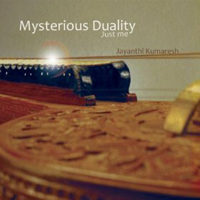 |
JAYANTHI KUMARESH |
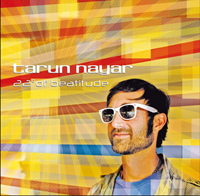 |
TARUN NAYAR |
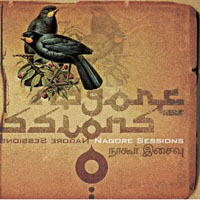 |
NAGORE SESSIONS (EarthSync)Another cross-cultural fusion. This time we find three Sufi singers from the Bay of Bengal on the southeast tip of India in full voice. Underneath their vocals we have the bowed fiddle-like sarangi, Tibetan horns and middle-eastern frame drums (not an outlandish grouping). The producers originally worked on the Laya Project then decided to go further with their winning formula. The electric bass and synthesizers add a Western structure that even verges on Led Zep's "Kashmir" in the opening cut "Bagdad Guru." Next up a flute augments the singing (in Tamil and Arabic dialects but still distinctly Indian) on "The Saint." There seem to be several offshoots of the Laya Project coming out all at once, this one is coherent & has really fine singing at the core. Patrick Sebag is the presiding guru on keyboards and programming. He does a fine job blending ancient Sufi singing with a modern framework to make it appeal to a new generation. |
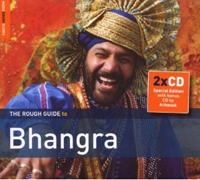 |
ROUGH GUIDE TO BHANGRA (World Music Network RGNET1202)The new Rough Guide to Bhangra is another remake. I am assuming the 2000 Rough Guide to Bhangra is out of print. Still, there is going to be confusion when people look for this and get that. Plus there is also their "Bhangra Dance" compilation. They call this one the "new edition" & it bodes well: they can revisit all of their compilations and perfect each of them. The old one had Malkit Singh, Nusrat and of course "Mundian to bach ke" by Panjabi MC. He returns (with a "Boliyan"), but Malkit Singh -- and Bally Sagoo -- are as dust, though they were huge a decade ago. Yes, Bhangra is ephemeral music, like all pop, but it does renew itself and become fresh to our ears, unlike Rock & Roll or mainstream pop. The Duchess & I sampled the top ten on iTunes (audio only) and there was not an original ditty among them all. It wasn't all Beatles or Madonna or Michael Jackson imitations but there was nothing distinguished or unique about any of it. Pity the youth of today. I bet Decca or Fontana could reissue the Searchers or the Swinging Blue Jeans (with the appropriate spotty youth lipsynching video) & top all the charts. So we turn to the land of the five rivers which spans Western India, Eastern Pakistan and Bradford, Yorkshire. And I guess the river Clyde is one of the rivers, since the Glaswegian group Tigerstyle is here too. The "typical" Bhangra sound in 8/8 time, with fast drumming and jerky tumbi accompaniment (which we associate with wedding dancers thrusting their arms in the air while pogoing on one leg and generally being idiotic), doesn't turn up until Dalvinder Singh's "Yaar da viah" which was a hit in 2007. Achanak who is another survivor of the purges of time gets a whole second disc to himself. What this release signals is that Bhangra was not a fad a decade ago and it has evolved and continues to produce new and interesting artists. |
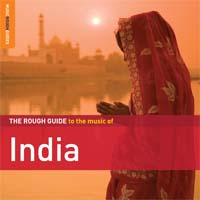
| ROUGH GUIDE TO THE MUSIC OF INDIA (World Music Network RGNET1231)This is a superb compilation, & definitely one to seek out. The featured disc has a wide range of talents from classical (Ravi of course) to pop with a double dip of Bollywood. The album opens with Asha Bhosle and closes with her sister Lata Mangeshkar. After a jazz outing "O, River" we finally get our toes in the Ganges with "Saravanabhava" by Aruna Sairam on warbly vocals with table and sitar accompaniment. The mood is mellow, but there are individual tracks that don't stand up on their own, like Seeta Doraiswamy's "Vatapi Ganapatim," which is a jolly clashing and bashing of bells (ringing water bowls actually) like a convention of ice cream trucks on a hot day: it's far too bright and brittle and goes on for five minutes, which is four and a half minutes too long (normally those guys never slow down long enough for you to actually get your money and get out there to buy a Mivvi.). But then we dip into the depths of India's soul with the incomparable Ravi Shankar and a raving jam called "Megh (Cloud)," which speaks of monsoons in a tempest of plucked notes that compress hours of thunder and downpour into a brief six minutes. We race to Chennai for the Karnatic sounds of T.H. Subashchandran on jew's harp and thence to the Northern deserts of Rajasthan for Vishwa Mohan Bhatt and his modified guitar, the Mohan veena, on an outstanding turn: a 16th-century Bhajan that combines Islamic praise singing with Hindu folk rhythms. This is a glorious centrepiece for the album. We stick with Sufism when the Wadali brothers show up for some Punjabi qawwals. This is all choice stuff: prime rib of the sacred Sufi cow. Another Punjabi, a snake charmer such as you might meet along the Grand Trunk Road playing for change, pops up next with his bagpipe-like skirl. A Kashmiri folk zither, the santoor, is plucked by Shivkumar Sharma while Zakir Hussain slaps his tablas, on a late night improvised raga. Tamil violinist L. Subramaniam is up next, accompanied by a double-headed drum, the mridangam, from the Karnatic camp. After a slow start the album attains a high peak and keeps hitting you with great selections. It's a whirlwind tour and ends too soon with another filmi sangeet involving more snakes, "Man dole mera tan dole," by Lata and Hemant Kumar. This is not your average Bollywood pick to click, it's an obscure gem from 1954's Nagin and is the first use of an electronic instrument in Bombay film. The clavioline was later popularised by the Tornados' "Telstar." Rough Guide has started adding bonus discs to their comps: this can make or mar a set, and this outing comes with a Debashish Bhattacharya album that is exceedingly fine. Recorded live at an all-night concert in Calcutta, Bhattacharya plays home-made slide guitars and has sitar-like resonating strings and tabla accompaniment so you get the full-on raga mode. It's wonderful music to nod out to. |
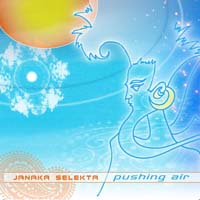
|
JANAKA SELEKTA |
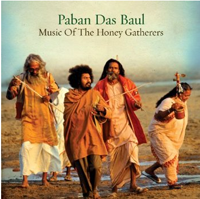
|
PABAN DAS BAUL |
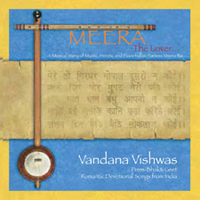
|
VANDANA VISHWAS |
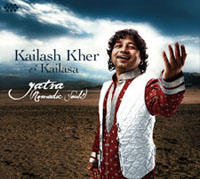
| KAILASH KHER |
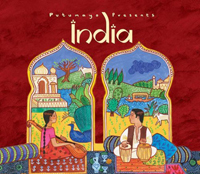
|
PUTUMAYO PRESENTS INDIA (PUT 288-2)This is a very pleasant set of contemporary Indian music. It's neither filmi not religious though it does include three songs from soundtrack albums and a couple of quasi-religious pieces. It steers a middle course so is mellow, verging on easy listening, but sometimes that's just the ticket. I saw a couple of music videos by Sona Mohapatra and thought she would start showing up on compilations like this but she is not here, however there are some old favourites like Susheela Raman and Deepak Ram, and relative newcomer Kiran Ahluwalia turns up too. Unlike Western pop stars, Indian vocalists are actually good singers, some of them really exceptional, like Swati Natekar, a traditional ghazal singer who graces Niraj Chag's song "Khwaab." Kailash Kher, a fine-voiced playback singer, fronts "Naino Sey," which is by session guitarist Sanjay Divecha. Tunes roll gently by with a dreamlike murmur, like wind or rain when you are half asleep. A.R. Rahman shows up with his hit "Tere Bina" from the film GURU. It's interesting that an outsider, like Cheb i Sabbah, gives a more telling portrait of India with his DEVOTION album than any recent anthology. The music is corny, schmaltzy even, and the devotional stuff gets a little shrill, but this Putumayo sampler weaves a pleasant flower-strewn path through contemporary sounds from the great subcontinent. |

|
RAVI SHANKAR |
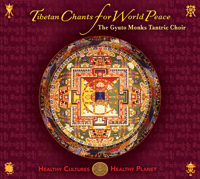
|
THE GYUTO MONKS TANTRIC CHOIR |
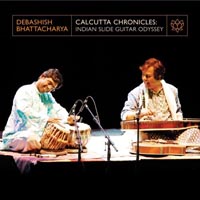
|
DEBASHISH BHATTACHARYA |
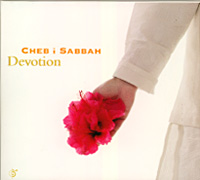
|
CHEB I SABBAH |

|
BISMILLAH KHAN |
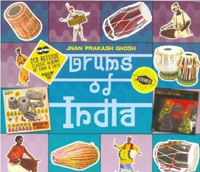 |
JNAN PRAKASH GHOSH |
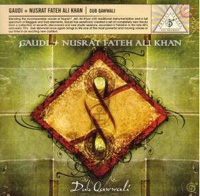
|
GAUDI + NUSRAT FATEH ALI KHAN |
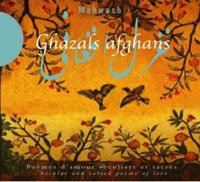
|
MAHWASH |
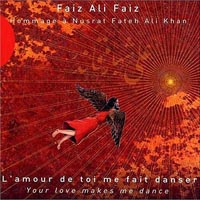 |
FAIZ ALI FAIZ |
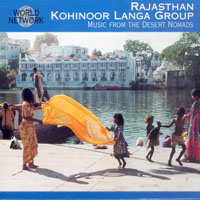 |
KOHINOOR LANGA GROUP |
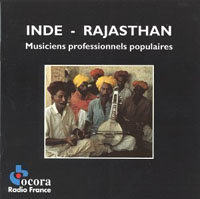 |
INDE -- RAJASTHAN |
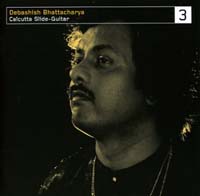 |
DEBASHISH BHATTACHARYA |
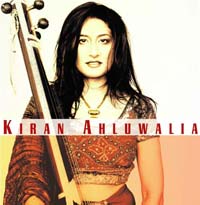 |
KIRAN AHLUWALIA (Triloka TRI-CD 82055)Here is a collection of contemporary ghazals that transcends boundaries. Kiran Ahluwalia is an Indian vocalist who grew up in Canada, but like many expatriates has guarded her musical heritage closely in her heart. She has assembled a great group of classical musicians and written melodies to accompany some lovely poetry. She also sprinkles her set with Punjabi folk songs. There is the suggestion of a synthesizer drone behind the opening track which gives it an unwelcome New Age flavour: the harmonium would have been enough. Kiran plays tanpura to back her singing, and it's really great to hear someone singing Indian love songs with a fine voice who is not Lata or Asha! But still you start seeing movies in your head when you hear this, it's unavoidable and she even quotes a few famous filmi riffs in her melodies (I cant name it, but I've seen the movie with the "Jhanjra" melody in it). The Beatles were famous for borrowing Indian sounds for their music, so here's a tit-for-tat: the guitarist quotes (perhaps unconsciously) "Something in the way she moves" in "Yeh Nahin"! Kiran's parents were pretty upset when she quit her stock-trading job in Toronto and went back to India to study music! She studied with Vital Rao, a 70-year-old performer who entered the household of the King of Hyderabad as a lad! Rao taught her the thousand-year-old tradition of Persian ghazals (which came to Indian with the Mughals in the 14th century) and she has mastered many of the forms and gone on to compose her own versions. To bring the ancient tradition to young audiences she explains that the ghazal is "just a highly literate pick-up line." She has been fortunate in finding expatriate Punjabi poets in Toronto who are also immersed in their folk traditions and have been writing poetry in this form, which she now sets to music and sings beautifully. Because Punjabi folk music also produced Bhangra we cannot expect Kiran to put us to sleep, and she does kick out the jams for "Meri gori gori," a rousing song about yellow bangles. |
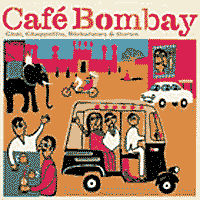 |
CAFE BOMBAY |
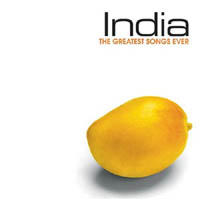 |
INDIA |
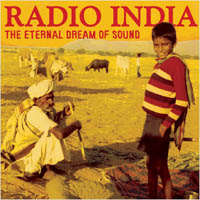 |
RADIO INDIA |
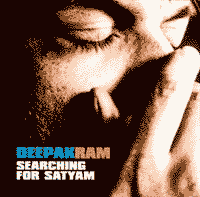 | DEEPAK RAM |
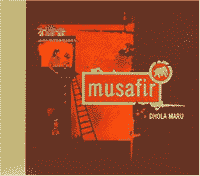 | MUSAFIR |
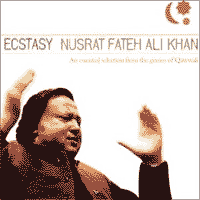 | NUSRAT FATEH ALI KHAN |
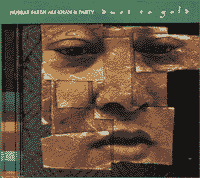
|
NUSRAT FATEH ALI KHAN & PARTY |
